This post may contain affiliate links. Please read our disclosure policy.
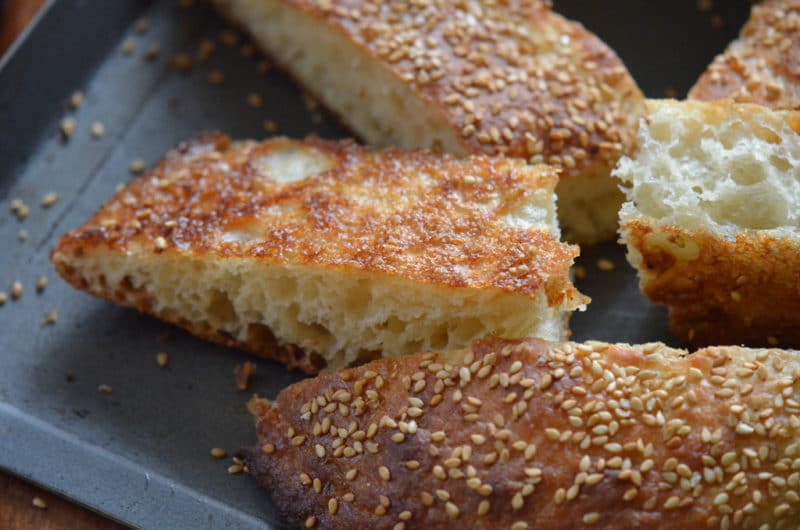
November, 2011.
Last Thanksgiving was my first one away from my family. That may sound wacky to some given that I’m not exactly a kid, but for the Lebanese among us it probably sounds about right. Our families tend to stay close, tight knit, which has its rewards (and, of course, its challenges). My plan to stay in San Francisco rather than trek across the country for Thanksgiving weekend was declared early on. Yet when the week arrived, I was uneasy. Anxious. Wondering what kind of crazy had been in my head when this decision was made. I started making calls. My mother and my sister. All of the brothers. My sister-in-law. My god-daughter. My Aunt Hilda. Not that they could do anything about it or that I was polling for what to do; I just felt the need to be…connected. “Are you concerned they will forget you?” someone asked. Hadn’t thought of it that way, but maybe so.
Then there was Jim. My cousin made the trip up to San Francisco from Arizona, where he too would have been a holiday orphan. Now there aren’t too many people who have as much fun doing just about anything than Jim. A trip to Best Buy with Jim is a good time. That’s because he appreciates the small things, especially the humor, in life. And—he can bake like a pro. He and his mother for years arrived on doorsteps of family throughout the city of Lansing with gorgeous baskets of bread, Lebanese-style talami warm from the oven with a towel draped over the top. O happy day. This talami exceeded our Sitto’s talami because it rose so high and had such tenderness.
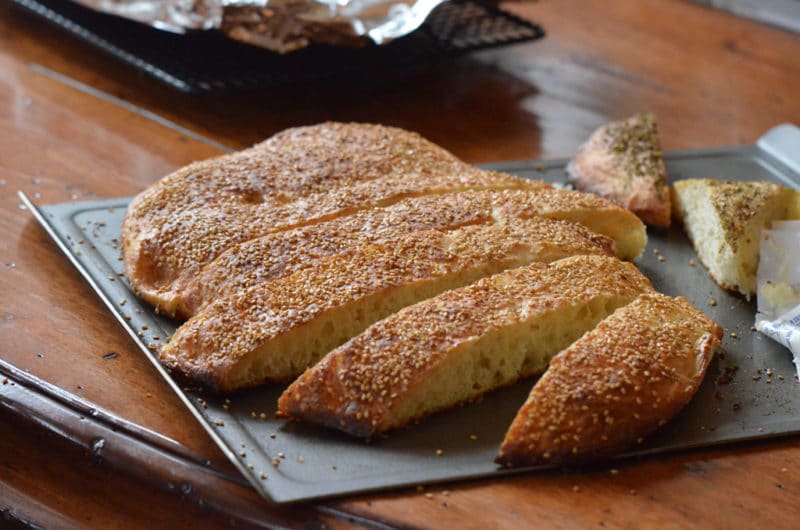
But even cousin would agree that the talami of all talami in our town was made not by him, not by Sitto, and certainly not by me. It was made by another Lebanese family, the Farhats, whose kitchen is revered, famed, and whose secrets have remained just that for most of us. When my brother Chris’s wife Ruth passed away two years ago at Christmas, the Farhats arrived immediately with loaf after loaf of warm talami. We stood around the kitchen island cutting slices off, loading the edges of the airy, soft bread with butter and salt, and eating with true abandon. We shook our heads in disbelief when we saw the bottom of the bread, crisp and golden. With each bite there were moans of relief, as the talami entered the body like an antidote to our pain.
How do they do it, was the question that lingered in our minds long after the last crumb was consumed.My sister Peg and I had a bake-off shortly after that in Chicago with cousins Celine and Sarah: 30 pounds of flour… and not a single good loaf was produced. We swore on Aunt Hilda’s cookbook that we’d never tell a soul, so please keep our failure to yourselves.
Then, there was last Thanksgiving. Jim arrived in San Francisco with the most precious gift of all time: the Farhat talami secret. How? How did you get it? I asked with truly bated breath. I asked them for it when I was in town, he said matter of factly, and they came over and showed me and my mom and my siblings (Jim’s one of ten) how to do it.

Funny how that works. You just ask for it. And you get it. That’s a lesson I’ve taken to heart ever since on everything from bread to chocolate, freely asking people to show me what they know so that I can know too. Not to mention other aspects of life, like love, that require one to take courage and ask for what is needed. And also not to mention faith, which requires us to take courage and ask God for what is needed, even if what we get is perhaps not we think we need.
So on Black Friday, after running around San Francisco to the Ferry Market and Chinatown while our dough rose (with Sitto’s signature cross in it as an insurance policy), we baked talami. We made a video of ourselves, capturing my disbelief when I discovered how wet the dough was. Wetter than pizza dough, dryer than batter. This isn’t dough that can be kneaded, it can only be, and must be, thoroughly incorporated. I was also shocked to learn that this talami had no oil in it, only on its surface when it rose and again when it baked.
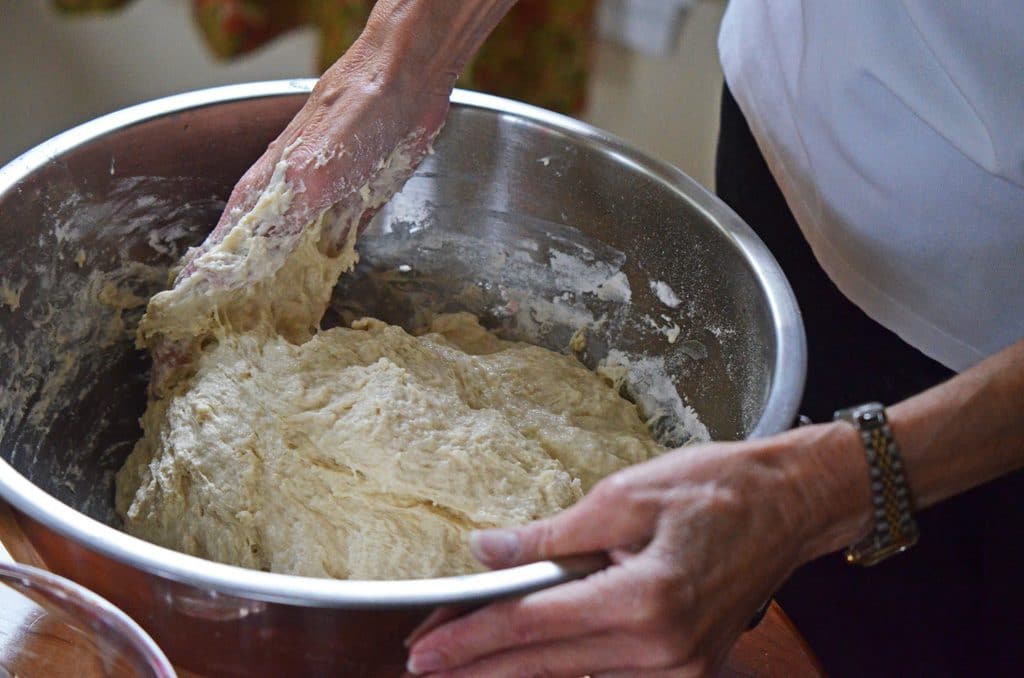
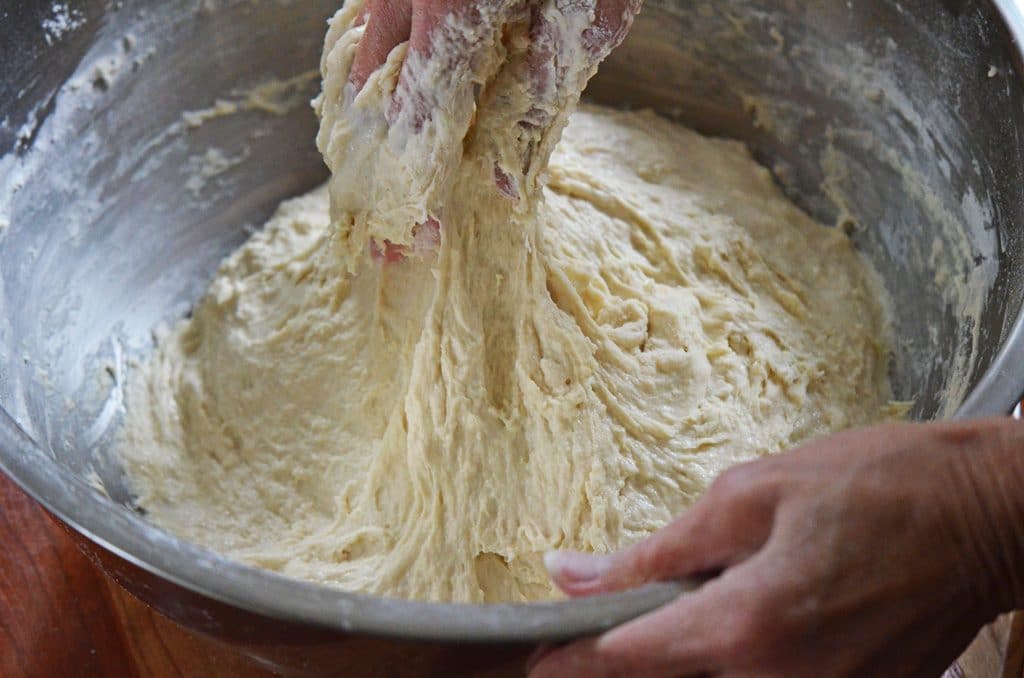
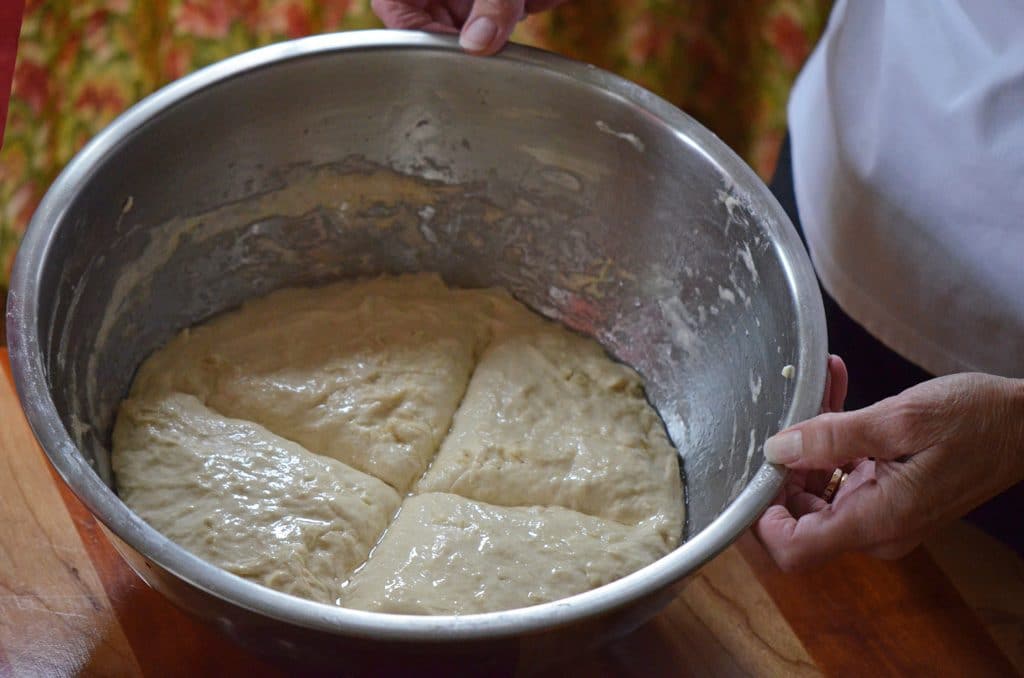
When I landed my post-culinary school internship at Boulette’s Larder in the Ferry building, part of our agreement was that I would bake and share my Lebanese breads. Never mind that I had only made the talami Farhat-style once, many months ago, with Jim. I went after it at Boulette’s with feverish determination, and delighted in hearing the front counter staff describe the “talami” to customers, and delighted in seeing the bread on the menu with chef’s exquisite Middle Eastern-inspired dishes. I baked the loaves like crazy and savored having a moment in which my lowly intern status was elevated to “she can actually do something” status, even if briefly.
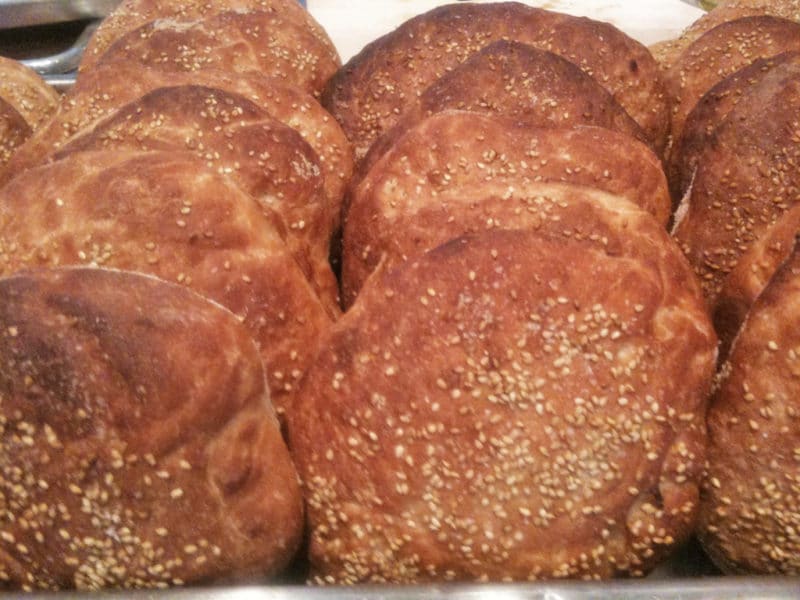

Since returning to the family fold in the last several months, the cousins and I have been talking bread-baking again. I’ve bragged with abandon about having learned the secret Farhat bread, and even let my hubris fly at Aunt Hilda’s funeral back in April, when I walked out of the wake gathering at Uncle Dick’s carrying a prized loaf of Farhat talami (again they knew what to do in the face of death: bake and give bread to the grieving). Another baking session was in order, and finally the cousins from around mid-Michigan decided to get together and get after the talami and other delicious yeasted dough delights.
Cousins Abood and our mamas (plus my Lebanese friend Geralyn who I’ve known since I was five, and her mama) arrived last Sunday armed for baking—there were rolling pins and sheet pans galore, more than we could possibly need but good to have, just in case. There were probably ten of us, equipped with snacks to get us through the day and a big pot of chili to offset our hunger until the bread would be pulled from the oven. Don’t forget the wine, which came out good and early. Last time when we baked in Chicago we went straight for the hard stuff, Lebanese arak liquor. I can’t recall if the arak caused our bad baking ju-ju or if our bad baking ju-ju caused us to break out the arak….
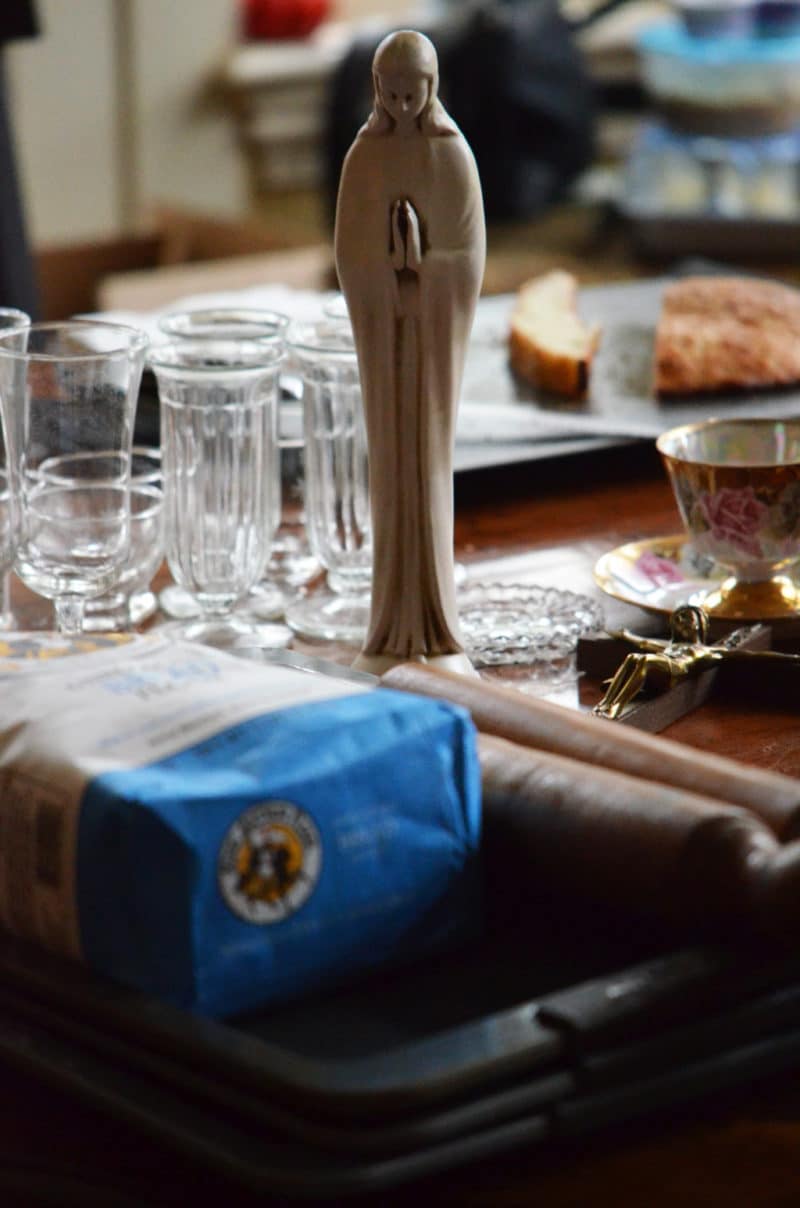
Our line-up this time included the stuffed Lebanese pies called fatayar, Lebenase flat bread Sitto-style, trays of baklawi in our orange blossom water syrup (you’ll get that one in December), and of course, the talami. Cousin Jim couldn’t be there but we spoke the day before, and he gave me the gems of his latest discoveries on the path to perfecting the talami. My kitchen notebook from my baking session with Jim last Thanksgiving reads “Talami, the Farhat Way,” but I’m prepared now to go the distance and call it “Talami, the Abood Way,” given all of our permutations. Is that wrong?
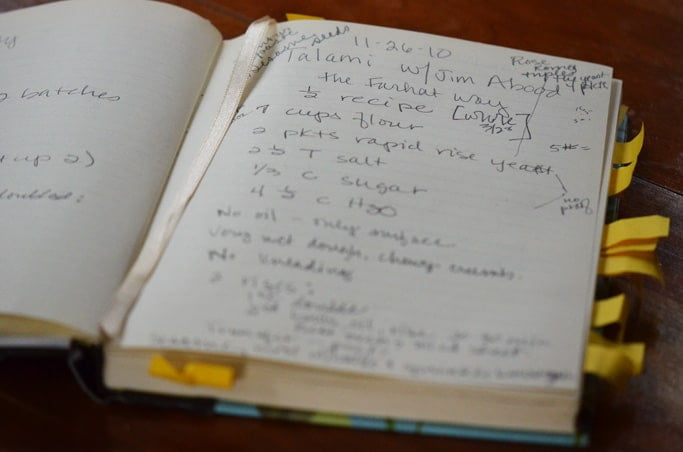
One of the funny things about the talami is that you’re never quite sure it’s going to come out as hoped. Last Sunday, we were baking so many different things, I worried it might be a doomsday. My sister Peg called from Chicago to ask how we could possibly have our gathering without Aunt Hilda. But then the table was covered with the last of the items from Aunt Hilda’s home that were brought by a cousin to give to anyone who wanted them, teacups and champagne glasses and a statue of the blessed Mother. Hilda is in heaven, but she was with us.
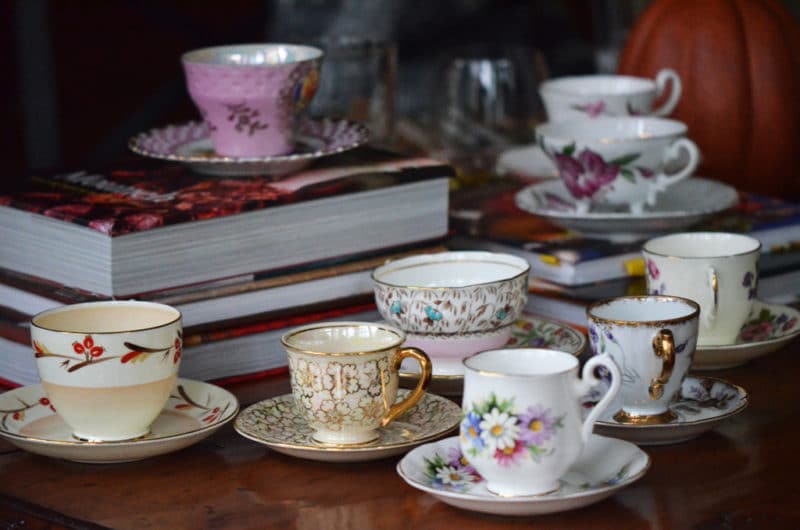
As the breads and baklawi came out of the oven, we wasted no time getting them into our mouths. Half the pleasure of this manna is eating it warm (the other half is getting your hands in the dough and making it). There were moans, there were gasps. I’ll say it in the style of Aunt Hilda whenever people enjoyed her food: “Honey, they RAVED about it!” When we turned the loaves of talami over and saw the crust perfection, cousin Cathy said in her soft voice of truth, “Now THIS is the body of Christ!” And she is right. We eat it as we do our communion, and it does what it should: it makes us better. It’s a holy bread that brings cousins together despite our many years of familial vicissitudes, a holy bread that conjures the souls of our faithful departed and heals the grieving, a holy bread that encourages us to ask, and allows us to receive.
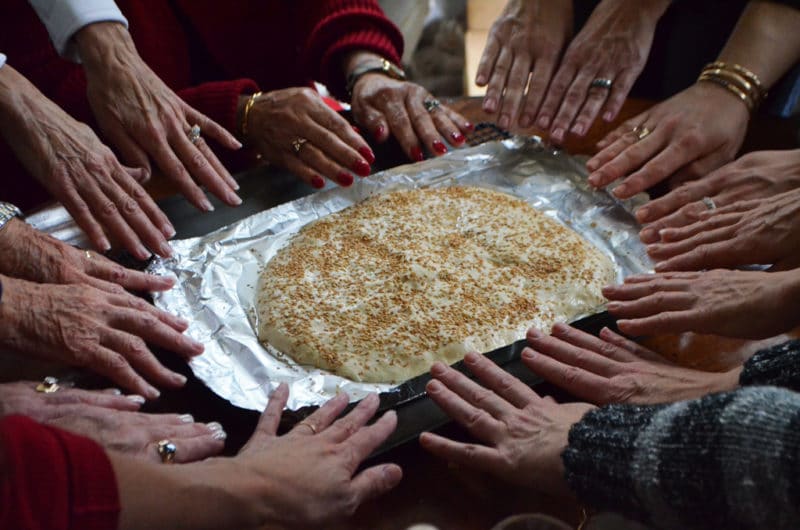
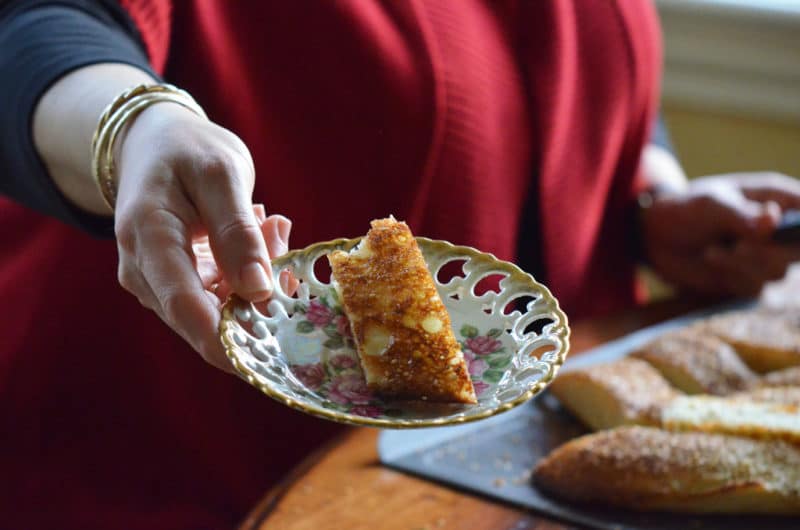
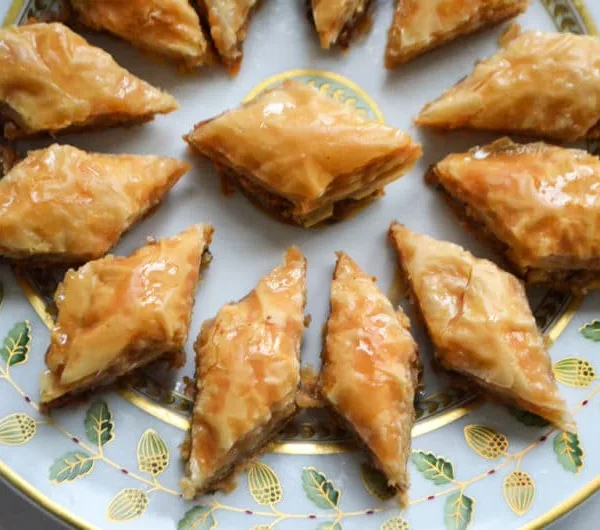
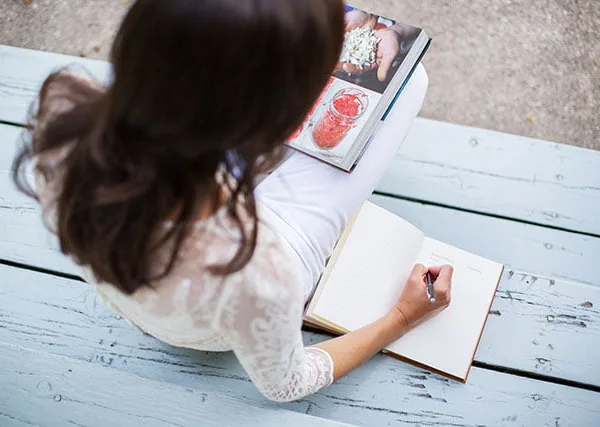
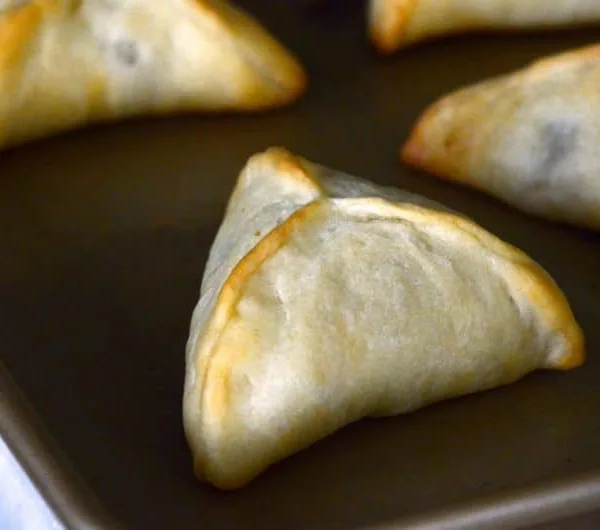
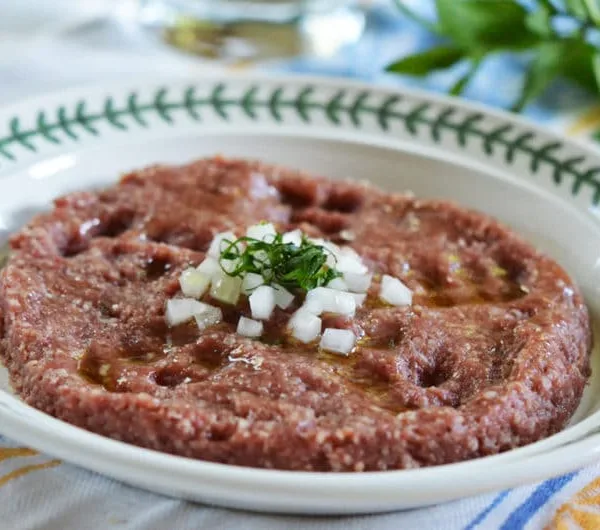







I remember Sitto and Jimmy baking in the big bright kitchen. I remember the flavor, the texture, and when lucky – the warmth! of syrian bread. Blessed by the neighbors! Thank you for this blog post and the memories!
Martha that is so special!! Thank you for chiming in with a special Sitto memory!!
Your stories always evoke fabulous memories of my mother’s family. The baking days, yes ma’am, I recall a few fried up donuts delicious. Oh and the whole story of getting a recipe. I the as 40yrs old when I finally just asked my Mother for her egg roll and wonton recipes. Mother had learned to cook other cuisines from the wives club when Daddy was in the military. Her learning Chinese spoiled us. I never tasted wontons as good. I’ve made them quite often for my husband and wherever he had been working. He was career military as well. Although I was Army I will on occasion cheer for his AF. But not last weekend during the army/af game.
Julie I love this, thank you!! I want those wontons! Those family football rivalries are the best, we have them going here too…
Hi this looks fabulous ! I want to make it , is this an everyday bread in Lebanon like pita? And is the amount of oil in your recipe correct seems excessive for brushing surfaces?
I just came across your blog this morning and after reading just this one recipe, I’m hooked. What wonderful stories too! As you can see from my last name, I too am Lebanese-American. I am still learning the secrets to my Sitto’s recipes, but I am loving everything about it. I can remember, as a child, be so elated to help her dump out 10 lbs of flour onto the table and being so intrigued while listening to her talk to the dough to get it to comply. I miss her dearly. Even today, baking Talami with my sister and Aunt Brenda, we channel her and listen for her instruction to “add more water!”
Thank you so much for sharing these stories and recipes. They remind me of my Sitto and Zhido and that food can bring together families, Lebanese or not.
Welcome here Stephanie! Wonderful to hear from you. “Listening to her talk to the dough” is beautiful!
I have searched but never found a recipe for Mwaraka or Mouwarka. It is a nut filled pastry that I had many years ago and would love to make myself. Can you help ? Love your site and the wonderful things you share with such emotion. Thank you
Hi Toni–thanks so much for your kind words. Check out a recipe and method for mouwarka here. Let me know how it goes!
Maureen, as always, so beautiful in words, spirit and pictures, but the circle of hands flooded my eyes with hot tears–the iconic expression of Lebanese mothers, daughters, sisters, aunts, nieces, grandmothers, all baking together, thru the ages–with great love–personifies the female version of the ‘laying on of hands’ in the Orthodox tradition when a priest is ordained so that each and every priest has been touched down thru the ages from the very beginning by the first. The very first time I ever baked bread (of course on a cold, snowy winter morning) in my very first home, I felt my Mother, and my Grandmothers for infinite generations, standing right behind me and guiding me. You are so lovely Maureen, you touch our hearts and evoke the strongest of memories, of childhood, of family.
I’m so touched Diane…many thanks for your beautiful thoughts and words.
I LOVE this! It reminds me of the days with my Sitie Minnie(grandmother) in Oklahoma, and my Aunt Mae, who always made Talami for us. This smells and tastes like love and home for me! I saw your recipe the week of Thanksgiving, so I took all of the ingredients to the ranch where my 3 grown children and their families and I were sharing Thanksgiving, and made it with my granddaughter. Special memories were made, and we all SO enjoyed it! I’ve made it several times since then. I can’t thank you enough for always sharing, not just the wonderful recipes, but the stories of our large, loving Lebanese families!
I’m so touched to hear this Denny! Isn’t that what it’s all about…thank YOU for sharing with me, and my warmest regards to you and your family.
Your photographs are always exquisite, but the photo of the circle of hands surrounding the loaf of bread was exceptional, and so moving.
This looks delicious! I have been looking for different ways of baking talami, other than the way my Grandma does it, but when you let it rise the second time, do you cover it with the plastic wrap and towel again?
Hi Shannon–I just coat the dough with plenty of oil (so it doesn’t form a skin) for the second rise and don’t cover it with plastic wrap and towel.
thanks! I cannot wait to try this!
Can I fry this talami for flatbread to make a wrap?
Interesting idea Jane! This dough is very wet, so it would be interesting to see how it performs if it was spread thin and fried for a flatbread–I haven’t tried that with the talami dough. My flatbread dough is much different, but that dough is thrown like pizza dough until it’s very thin. If you do try it, I’d love to know how it turns out!
Yes, Actually I had more dough than the cake pan (as mentioned above) would hold so I put some in muffin tins (sprayed) and baked it with the bread on the cake pan and it seemed to come out better than that on the cake pan. I did actually put too much dough in the muffin tins and they really rose big. Maybe because there was more surface than with a loaf so the yeast was able to become warmer. (I don’t have a warm house this time of year so let it rise in a warm oven.) Anyway I got the big bubbles with one rise and better than with one or two rises trying to do it as a single loaf. Really love your recipes, but as you can see I also like to experiment. Have you looked at the web site supercook.com ? It’s a search engine for recipes where one puts in everything in the kitchen and it searches for all the recipes on the net that you can make with what you have on hand. I make something new several times each week.
I see, so one rise accomplishes same as two given that it’s not really touched, so it maintains the big bubbles. I will try this because I’ve been very curious about not touching the dough for a second rise, since it deflates it so much. Supercook.com looks fantastico too!! Thanks for all of these great tips Roger! I love it.
Roger, I wonder if you could write down step-by-step what you did. Using the muffin tin, how many do you end up with? Thanks.. BTW, I see you are on the Shada Family FB page.
A little different in the way it is served, but try putting this in muffin tins and allow it to raise there then bake as usual. The texture comes out just right. Of course you don’t have the community loaf of bread but the taste and holes come out with ease.
That’s intriguing Roger…I’ve been wondering about eliminating touching the dough at all for both rising processes, in order to preserve the air bubbles. Are you saying that you put it in the muffin tins for the first rise, and then no second rise?
OK, fourth time is the charm. I added more sugar and water. Decided moving it caused the loss of bubbles so lined a shallow cake pan with parchment paper and then oiled it. Put the dough directly in the pan and let it raise there. Baked it the required time and it came out looking like yours. The first 3 times I got good bread but not the proper texture.
Fantastic. Your process surfaced the same issues mine did, ending on the necessity for the second rise to be on the pan it will bake in/on, for less disturbance of the air bubbles.
Maureen,
That Talami looks irresitible. And your telling of the story is, as usual, evocative and heartfelt. Looking forward to learning about baklawa!
Thank you Greg–coming from a master artisenal baker like you, that means a lot!
Maureen,
Awesome! You all really rocked the Talami! The memories of our Thanksgiving last year are priceless. We had so much fun! Your blog is inspiring us all. What a great way to nurture the Art of Lebanese cooking. Love you!
Growing up in Beirut we did not eat talami; I guess this was a rural bread that bakers in the city stopped making. I thought when I saw it that the dough was similar to baguette dough which is very wet. Your bread turned out wonderfully and I will make it soon! Great story too.
What great writing great pics my mom would be so proud of the whole dAy we all spent together she was there as our angel and sito too can’t wait til next time thank you for all u did the food was all excellent! Everyone did a great job our hands showed it ur the best maureen enjoy florid rest u need it. Love u
Cousin,
Your writing of the afternoon we all spent together is awesome. I love being a part of a bunch of Lebanese foodies who can talk, laugh and endlessly discuss the intracacies of the perfect loaf of talamie. The quest is over with your recipe this week. Aunt Hilda would rave about your pictures too! Simply beautiful.
Celine, thank you for the wonderful energy you bring to all that you do! Our baking day was special and I’m looking forward to more!
Even though we’ve never lived in the same city, Maureen, you and I are friends just the same, and I think that one of the reasons I so love your blog is that reading it is a way of having you nearby, of hearing your “voice” and your warm nature come through the words you choose. The food information is wonderful, and the recipes all sound great, but even without them, these posts would be a gift. Thank you.
Sofia, you understand story better than anyone. Thank you for reading, and knowing, and sharing. My dear friend across the miles.
BRAVO!!!!!!!!
You are the best! Reading this just made my day! I am still so thrilled that Mom and I were able to join you on Sunday. I have been raving about your talami all week long. At first I thought it was because it was still warm from the oven–but no–even days later when the talmi was cold it was still amazing!
This sounds just delicious!! I think I need to get home and bake some bread!!!!